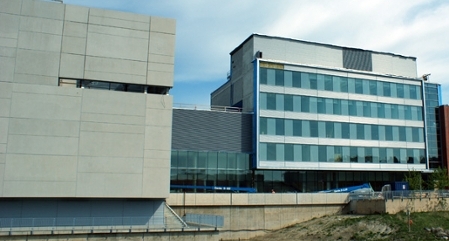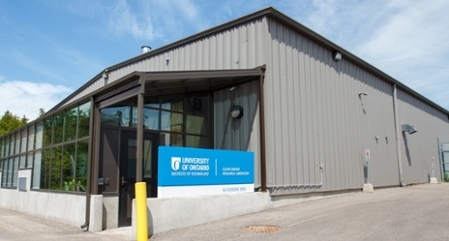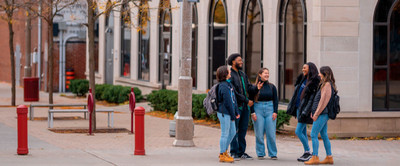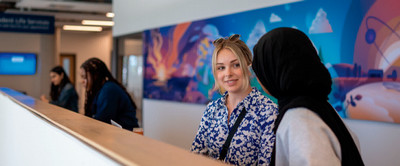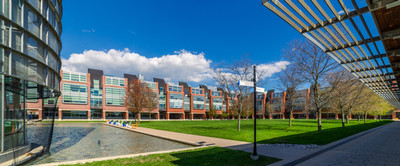Infrastructure growth
Pre-2003: How Durham Region’s dream of a university became reality
As a rapidly growing centre of industry and innovation in the eastern Greater Toronto Area, throughout the 1980s and early 1990s leaders in Durham Region cherished the dream of establishing its own university. At the time, the number of residents in Durham Region was projected to approach nearly one million by 2021.
For more than a decade, prominent figures in the community developed a vision for a student-focused institution dedicated to great teaching, groundbreaking research, and the use of leading-edge learning technology. The dream was to build a university that would offer programs to prepare students for critically needed, knowledge-intensive careers. This university would ensure bright futures for its graduates and generate economic growth for Durham Region, Northumberland County and the entire province.
In one of the earliest efforts in Ontario to combine university and college studies in one location, the Durham University Centre was created in 1996 at the same location the university today shares in north Oshawa with Durham College. Although the university courses offered at the centre were taught by professors from both Trent University and York University, the community never abandoned its desire for a made-in-Durham university.
May 9, 2001 was an historic day for Durham Region and Northumberland County. The Government of Ontario announced plans for the first brand new university in the province in 40 years, earmarking $60 million in startup funds through Ontario SuperBuild Corporation. An operations centre was immediately established next to the Durham College President's office where 11 teams, working seven days a week, produced a to-do list of 856 tasks and hundreds of sub-tasks. Team members toured top institutions across North America to study best practices.
The university officially came into being on June 27, 2002, with the legislature's passage of Bill 109, Schedule O, the University of Ontario Institute of Technology Act, 2002. Administrators had 14 months to prepare for opening day in September 2003. The university would become Ontario’s first university to use the latest technology to deliver its curriculum, giving students a competitive edge in tomorrow's workplace.
The university met that challenge welcomed its first class of 947 students on September 4, 2003, ushering in a new era of post-secondary in Durham Region and in Ontario.
The first decade: 2003-2013
The university's early history was marked by tremendous accomplishment and growth, all boosted by government, community and donor support.
The university’s first two state-of-the-art academic buildings–the Science Building and Business and Information Technology Building–as well as its architecturally award-winning Campus Library were completed by Fall 2004. Each was designed by Diamond and Schmitt Architects Inc.
Thanks in part to a $10-million, multi-year partnership with Ontario Power Generation (OPG), the university opened the OPG Engineering Building in early 2007. The large three-storey building houses 17 state-of-the-art labs that were carefully equipped to provide innovative and industry-specific technology for the university's Engineering students. The OPG partnership continues to be renewed every five years.
On June 1, 2007, the university celebrated its historic first all-faculty Convocation. The ceremony saw the conferring of nearly 700 degrees to next-generation scientists, engineers, IT security specialists, health-care professionals, criminal justice experts, teachers and business leaders.
Also that year, the 8,400 square metre Campus Recreation and Wellness Centre (CRWC) opened, featuring a huge cardio, weight and fitness centre overlooking Oshawa Creek and green space. The CRWC also houses a triple gymnasium for intramural and varsity sports; a 200-metre indoor jogging track overlooking the gym space; two large aerobic/dance studios; as well as other training rooms, lounges and club offices.
Also in 2007, the campus expanded north across Conlin Road, thanks to the estate of industrialist E.P. Taylor and the donation of a portion of Windfields Farm, a world-class thoroughbred racing operation that once nurtured the great champion Northern Dancer. On this property stands the Campus Ice Centre (featuring two NHL-size ice pads, 10 change rooms, and 2200 North, a full-service restaurant); along with the year-round Campus Fieldhouse sports facility. To the south of Brittania Road West, Ontario Tech also maintains a number of former Windfields Farm structures, operated primarily by the Office of Campus Infrastructure and Sustainability. Another Windfields building serves as Crime Scene House, a key component of the Faculty of Science’s Forensic Science program.
The university has also developed a significant presence in downtown Oshawa. In 2008, the Faculty of Education relocated to a refurbished building at 11 Simcoe Street North. Two years later, the Faculty of Social Science and Humanities moved into Bordessa Hall at 55 Bond Street East. the university’s downtown Oshawa footprint also includes the 61 Charles Street Building, the Regent Theatre at 50 King Street East, and sixth-floor space at 2 Simcoe Street South.
In 2010, the multi-million-dollar Clean Energy Research Laboratory (CERL) opened. CERL houses the first lab-scale demonstration of a copper-chlorine cycle for thermochemical water splitting and nuclear hydrogen production. Hydrogen is a clean energy carrier of the future and potentially a major solution to the problem of climate change.
To further support its expansion efforts, the university received $73.4 million in funding through the joint federal and provincial Knowledge Infrastructure Program toward the construction of two buildings at the north Oshawa location. The Automotive Centre of Excellence (ACE) Core Research Facility and the Energy Research Centre (ERC) both opened in 2011. ACE is the first commercial research, development and innovation centre of its kind in Canada, and the ERC serves as the premier training ground for future energy scientists and nuclear engineers while fostering research in the development of clean and green energy and technology. ERC is home to the Nicholas Sion Research Laboratories.
The second decade: 2013-2023
In 2014, the university officially opened the Baagwating Indigenous Student Centre at the downtown Oshawa location. The centre recognizes and celebrates Indigenous histories and cultures, enhancing the university’s unwavering commitment to the success of all students.
In 2015, following two years of extensive consultation with stakeholders, the university completed the Campus Master Plan, the document that guides expansion proposals for the development of 190 acres of property to the north and west of the Simcoe Street/Conlin Road intersection (the former Windfields Farm lands).
In 2017, the university opened the Software and Informatics Research Centre (SIRC) a hub for research in health and business analytics, IT security, networking, gaming, and software engineering. SIRC promotes interdisciplinary and experiential learning for students in computer science, IT and engineering. SIRC also enables e-learning and more e-guest lectures and interactions with industry through innovative digital and conferencing technology. SIRC is also the home of the Office of the Registrar and additional student services.
In 2021, Ontario Tech opened Shawenjigewining Hall, a four-storey, 7,400-square-metre building adjacent to the Campus Library and the Energy Research Centre, completing the university’s quad—Polonsky Commons. Shawenjigewining Hall includes Mukwa’s Den, an Indigenous space that offers a home away from home for Indigenous students, and space for all students to connect and learn from Indigenous culture and resources. It is also home to the Faculty of Health Sciences, Office of Student Life, Continuous Learning, and the Ontario Tech Student Union.
The building offers technology-enhanced academic, administrative and student support spaces, research labs, classrooms and faculty offices, a range of study and lounge areas, and space for student-run societies and clubs.
In 2022, the university purchased a parcel of land at 154 Bruce Street (to the southeast of Charles Hall), signalling future growth plans at the downtown Oshawa location during the university’s third decade.
By Summer 2023, the university's enrolment exceeded 11,000 undergraduate and graduate students. Through Convocation 2023, the university had conferred more than 29,000 degrees – bachelor’s, master’s and PhDs.
